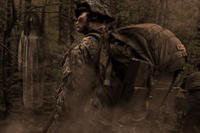The Marine Corps' long-awaited Joint Light Tactical Vehicle is expected to start hitting the fleet next year, but not all of its parts will be fresh off the assembly line.
A harvesting effort is underway to salvage Humvee parts that can be fitted onto the JLTV. The strategy has long been part of the plan as the service phases out the unpopular Humvee for the JLTV, a faster vehicle with better armor to protect Marines from roadside bombs and rocket-propelled grenades.
The move could save the Corps more than $100 million, according to a service news release.
All JLTVs will have radios, antennas and other communications equipment taken from Humvees. Two JLTV variants will also be equipped with elements of Humvees' Gunner's Protection Kits -- transparent armor gun shields that protect gunners when they stand in the vehicles.
The heavy-guns carrier variant of the JLTV will be equipped with Marine Corps Transparent Armor Gun Shields taken from Humvees. The Improved TOW Gunner's Protection Kits -- which can be armed with tube-launched, optically tracked, wire-guided missiles -- will be added to the close-combat weapons carrier variant.
"It's our responsibility ... to be good stewards of taxpayer money, so if we have equipment that is in good condition, we should go ahead and use it," Kevin Marion, a logistics management specialist in Infantry Weapons, said in the release.
The Corps plans to purchase nearly 10,000 JLTVs in coming years. The Navy Department's 2019 budget included a request for $607 million to purchase more than 1,642 of the vehicles.
Marines at the Schools of Infantry in North Carolina and California, officers at The Basic School in Virginia, and Motor Transport Maintenance Instructional Company in North Carolina will be the first to receive the JLTV in the spring. The vehicles are expected to reach the operating forces starting next summer.
Marine Corps field-service representatives will continue equipping JLTVs with the Gunner's Protection Kits even after the first crop enters the fleet. As the vehicles are fielded, the parts will be harvested and installed and the vehicles returned to their units, according to the release.
-- Gina Harkins can be reached at gina.harkins@military.com. Follow her on Twitter at @ginaaharkins.










